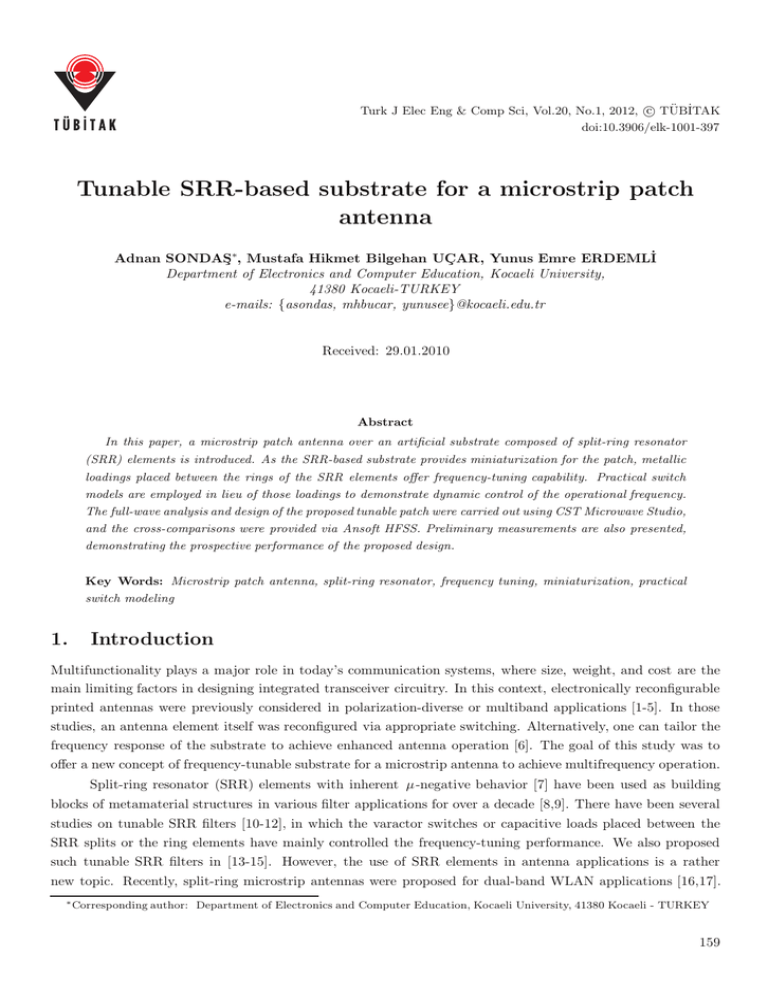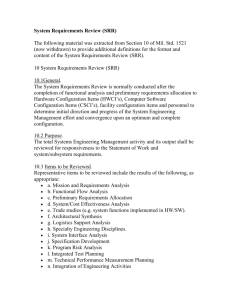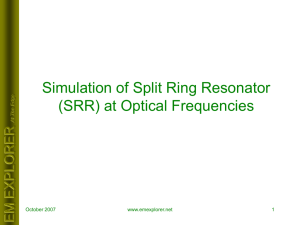Tunable SRR-based substrate for a microstrip patch antenna
advertisement

c TÜBİTAK
Turk J Elec Eng & Comp Sci, Vol.20, No.1, 2012, doi:10.3906/elk-1001-397
Tunable SRR-based substrate for a microstrip patch
antenna
Adnan SONDAŞ∗, Mustafa Hikmet Bilgehan UÇAR, Yunus Emre ERDEMLİ
Department of Electronics and Computer Education, Kocaeli University,
41380 Kocaeli-TURKEY
e-mails: {asondas, mhbucar, yunusee}@kocaeli.edu.tr
Received: 29.01.2010
Abstract
In this paper, a microstrip patch antenna over an artificial substrate composed of split-ring resonator
(SRR) elements is introduced. As the SRR-based substrate provides miniaturization for the patch, metallic
loadings placed between the rings of the SRR elements offer frequency-tuning capability. Practical switch
models are employed in lieu of those loadings to demonstrate dynamic control of the operational frequency.
The full-wave analysis and design of the proposed tunable patch were carried out using CST Microwave Studio,
and the cross-comparisons were provided via Ansoft HFSS. Preliminary measurements are also presented,
demonstrating the prospective performance of the proposed design.
Key Words: Microstrip patch antenna, split-ring resonator, frequency tuning, miniaturization, practical
switch modeling
1.
Introduction
Multifunctionality plays a major role in today’s communication systems, where size, weight, and cost are the
main limiting factors in designing integrated transceiver circuitry. In this context, electronically reconfigurable
printed antennas were previously considered in polarization-diverse or multiband applications [1-5]. In those
studies, an antenna element itself was reconfigured via appropriate switching. Alternatively, one can tailor the
frequency response of the substrate to achieve enhanced antenna operation [6]. The goal of this study was to
offer a new concept of frequency-tunable substrate for a microstrip antenna to achieve multifrequency operation.
Split-ring resonator (SRR) elements with inherent μ-negative behavior [7] have been used as building
blocks of metamaterial structures in various filter applications for over a decade [8,9]. There have been several
studies on tunable SRR filters [10-12], in which the varactor switches or capacitive loads placed between the
SRR splits or the ring elements have mainly controlled the frequency-tuning performance. We also proposed
such tunable SRR filters in [13-15]. However, the use of SRR elements in antenna applications is a rather
new topic. Recently, split-ring microstrip antennas were proposed for dual-band WLAN applications [16,17].
∗ Corresponding author:
Department of Electronics and Computer Education, Kocaeli University, 41380 Kocaeli - TURKEY
159
Turk J Elec Eng & Comp Sci, Vol.20, No.1, 2012
SRR elements were also utilized as composite substrates providing miniaturization for patch antennas [18-20].
There was no frequency-tuning capability reported in those antenna studies. In this research, we propose a new
switching configuration to dynamically control the frequency behavior of the SRR substrate placed underneath
a patch antenna. To the best of our knowledge, the proposed configuration presented in this study is the first
utilization of tunable SRR elements in an antenna application.
We propose an artificial substrate composed
miniaturization for a microstrip patch antenna. The
loadings placed appropriately between the rings of
previously employed in recent SRR filter structures
of SRR elements providing frequency tuning as well as
frequency tuning is achieved by means of several metallic
each SRR element. Similar loading configurations were
[13-15]. In practice, those loadings may be replaced by
on/off switches for dynamic frequency tuning. In this paper, we also consider practical switch modeling in the
SRR-based substrate to demonstrate possible switch effects on the patch performance. Furthermore, preliminary
measurement results for the proposed SRR substrate with metallic loadings are presented, demonstrating
promising tunable patch operation.
The full-wave analysis of the proposed antenna design was carried out using CST Microwave Studio based
on the time-domain finite-integration technique. The cross-comparisons were provided by using Ansoft HFSS,
which utilizes the frequency-domain finite-element method.
εr
r
Patch
h
W
GP
Feed
L
t
t
s
SRR slabs
d
εr
d
x
z
y
Figure 1. Proposed MPA/SRR configuration: L = W = 21, r = 5, h = 4.5, t = 0.5, s = 3, d = 1, all in mm;
εr = 2.2.
s1
w
s1
g
s2
s2
L2
L1
g
s3
s3
Figure 2. Proposed tunable SRR configuration: L1 = 3.5, L2 = 2.5, w = g = 0.25, all in mm.
160
SONDAŞ, UÇAR, ERDEMLİ: Tunable SRR-based substrate for a microstrip patch antenna...,
2.
Numerical design
We now introduce the microstrip patch antenna (MPA) design over the frequency-tunable SRR-based substrate.
The proposed MPA/SRR configuration is depicted in Figure 1. As shown, the MPA excited by a 50- Ω coaxial
feed is placed over a composite substrate consisting of 8 SRR slabs, all backed by the ground plane (GP). Each
SRR slab contains 5 SRR elements supported by a thin substrate (Rogers RT/duroid 5880, t = 0.5 mm, εr =
2.2), and each SRR element includes 3 pairs of metallic loadings or pads (s1 , s2 , s3 ) appropriately inserted
between the rings (Figure 2) for frequency-tuning purposes. To achieve the desired antenna performance, the
SRR splits as well as the SRR slabs are placed along the same direction with the E-field excited on the antenna
element.
The full-wave analysis and design of the tunable MPA/SRR structure were carried out using CST
Microwave Studio, and the cross-comparisons were provided by means of Ansoft HFSS. We carried out a
number of parametric studies to achieve the optimum design parameters. The optimization was processed using
the automatic optimization tools available in the simulators. The critical parameters considered in that process
were SRR dimensions, the placement of SRR elements with respect to the patch, the locations of the metallic
loads (switch location in a practical realization), the placement of the feed, and the patch dimensions.
The return loss characteristics of the MPA/SRR designs via 2 different simulators are displayed in Figure
3. As seen, the simulation results are in quite good agreement. While the MPA in the absence of the SRR
slabs (that is, the MPA backed by the substrate with a thickness of t = 0.5 mm is placed over an air-filled
cavity at a distance of h = 4.5 mm above the GP) has a resonance around 5.65 GHz, the inclusion of the SRR
substrate without loadings results in the reduced resonance frequency of 4.35 GHz and thus miniaturization
with a ratio of 1.3. More importantly, when each pair of loadings (s1 , s2 , s3 ) is individually placed in the
corresponding locations, the resonance shifts upwards to a respective frequency as compared to the no-loading
case, as seen in Figure 3. In particular, the loadings placed equidistant from each of the splits (s2 ) provide
an operation around 4.75 GHz, whereas the loadings closer to the split of the outer ring (s3 ) and the loadings
closer to the split of the inner ring (s1 ) allow for operation at a higher band (around 4.85 GHz) and at a lower
band (around 4.6 GHz), respectively. Hence, the tunable MPA/SRR design offers a frequency-tuning operation
over a band of 4.3-4.9 GHz with almost 7% bandwidth (S 11 < −10 dB with a 50- Ω system impedance) for all
cases considered. In addition, by varying the locations of the loadings around the loop between the rings, the
corresponding resonant frequencies may be adjusted to desired frequencies within the band of interest. Also
note that, when more than one pair of metallic pads is present in the SRR elements at the same time, the patch
does not resonate in the corresponding band.
The pattern/gain characteristics are almost not altered due to the loaded SRR substrate, and thus all
of the designs considered result in similar radiation characteristics. As a representative radiation performance,
the broadside radiation patterns (2D and 3D) at 4.85 GHz are displayed for the MPA/SRR configuration with
s3 loadings in Figure 4. As can also be seen in the Table, the MPA/SRR designs offer a directivity of about
8 dBi, which is almost 1 dB less than that of the MPA in the absence of the SRR slabs. This small reduction
in the directivity due to the loading effect of the SRR is not critical since the directivity performance is not a
priority of the proposed design. We also note that the computed radiation efficiencies for all of the MPA designs
presented here are better than 98%.
161
Turk J Elec Eng & Comp Sci, Vol.20, No.1, 2012
0
-5
S11 (dB)
S11 (dB)
-10
-15
-20
-25
-30
(b)
(a)
3
3.5
4
without SRR
4.5
5
5.5
Frequency (GHz)
6
6.5
7
SRR+ s 1
with SRR
SRR+ s 2
SRR+ s 3
Figure 3. Return loss characteristics of the MPA/SRR design via a) CST and b) HFSS.
=0 o
30 o
30 o
60 o
60 o
90 o
90 o
40
20
0dB
H-plane
E-plane
(a)
y
z
Theta
dbi
8.34
Phi
x
5.39
3.43
1.47
0
-9.31
-16.8
-24.2
-31.7
f =4.85 GHz
D 0=8.34 dBi
(b)
Figure 4. Radiation patterns of the MPA/SRR design with s3 loadings for f = 4.85 GHz, a) 2D and b) 3D.
162
SONDAŞ, UÇAR, ERDEMLİ: Tunable SRR-based substrate for a microstrip patch antenna...,
Table. Directive gain performance of the MPA/SRR designs.
Directivity
D0 (dBi)
MPA/SRR designs
With SRR, SRR+s1 , SRR+s2 ,
4.35 GHz
4.6 GHz 4.75 GHz
7.75
8.05
8.2
Without SRR,
5.65 GHz
8.7
SRR+s3 ,
4.85 GHz
8.34
In practice, low-loss and high-isolation surface-mounted on/off switches (MEMS switches, PIN diodes,
etc.) may be employed in lieu of those metallic loadings for dynamic control of the operational frequency. To
demonstrate possible effects of the practical switches on MPA/SRR performance, we modeled the loadings as 2legged bridges based on cantilever MEMS switch structure [21], as depicted in Figure 5. As seen, this simplistic
model consists of a copper strip placed on 2 copper legs when the particular switch (s2 ) is in the on-state. For
the off-state, the copper strip is placed on only one copper leg (s1 and s3 ), while a possible capacitive effect
is expected. A representative return loss (S 11 ) performance of the MPA/SRR design with the MEMS switch
model is also shown in Figure 5. As seen, by the inclusion of the switch model, the frequency response is shifted
downwards slightly (approximately 0.1 GHz) as compared to the response of the metallic-pad modeling (see
Figure 3).
s2
s1
s3
s2
0
-5
S11 (dB)
-10
All OFF
-15
s 1 ON
-20
s 2 ON
-25
s 3 ON
-30
3
3.5
4
5
4.5
5.5
Frequency (GHz)
6
6.5
7
Figure 5. Frequency-tuning performance of the MPA/SRR design with bridge MEMS modeling. The switch positions
s2 -ON and s1 / s3 -OFF are depicted.
In the analysis, we also considered electrical equivalent models for practical PIN diodes in place of the
metallic loadings. We modeled the loadings as capacitors (C = 0.3-1 pF) and resistors (R = 1–5 Ω) when they
were in the off-state and the on-state, respectively, as depicted in Figure 6. Those capacitor and resistor values
represent actual switch behavior in an approximate manner. The PIN-diode as well as MEMS switches would
have inductive effects on the frequency response. However, in the analysis, we mainly focused on the capacitive
163
Turk J Elec Eng & Comp Sci, Vol.20, No.1, 2012
effect, which is considered to be the predominant one. A similar yet smaller effect on the tuning performance
is expected with the inclusion of the inductive loading.
+
VD >0
ON
+ VD
ID > 0
+
ID
PIN Diode
R
VD < 0
OFF
ID ≅ 0
C
Figure 6. Simple circuit modeling of the PIN diode switch used in the analysis.
The S 11 performances of the PIN diode and the MEMS switch models are shown in Figure 7 for
comparison purposes. As seen, by the inclusion of the PIN model, the frequency response was shifted by
0.3 GHz on average as compared to the response of the bridge modeling. There was almost 5 dB of difference,
0
-5
S 11 (dB)
-10
s3 −ON
s1 /s
/ 2 −OFF
-15
1Ω − 1pF
-20
MEMS
5Ω − 1pF
-25
c
-30
4
4.5
5
Frequency (GHz)
0
0
-5
-5
-10
s 1−
−ON
−OFF
s 2//s 3−
S 11 (dB)
S 11 (dB)
3.5
1Ω − 1pF
-15
-10
5.5
6
s 2−
−ON
s 1/s 3−OFF
−
MEMS
-15
MEMS
-20
-20
5Ω − 1pF
5Ω − 0.3pF
1Ω − 0.3pF
(a)
-25
3.5
-25
4
4.5
5
Frequency (GHz)
5.5
6
3.5
4
5Ω − 0.3pF
4.5
5
Frequency (GHz)
(b)
5.5
6
Figure 7. Return loss characteristics of the MPA/SRR design for MEMS (bridge) and PIN diode (circuit) models: a)
s1 -ON and s2 / s3 -OFF, b) s2 -ON and s1 / s3 -OFF, c) s3 -ON and s1 / s2 -OFF.
164
SONDAŞ, UÇAR, ERDEMLİ: Tunable SRR-based substrate for a microstrip patch antenna...,
on average, in the corresponding S 11 levels. These variations due to tolerable switch effects are to be expected.
The MPA/SRR design parameters in the presence of practical switch models can be reoptimized to achieve the
performance in the desired frequencies. More importantly, the results promise frequency-tuning performance of
the proposed MPA/SRR design in a practical implementation.
Figure 8. Fabricated MPA/SRR (no loading) prototype, of which 2 perspective views are shown.
3.
Measurements
In order to validate the proposed tunable SRR-based substrate, 3 prototypes for the MPA/SRR designs were
fabricated and return loss measurements were carried out. One of the prototypes consisted of the MPA in the
0
-10
MPA w/o SRR
MPA w/ SRR
S11 (db)
-20
-30
MPA w/ SRR+ s 3
-40
Simulations
Measurements
-50
3
3.5
4
4.5
5
5.5
Frequency (GHz)
6
6.5
7
Figure 9. Simulated versus measured return loss characteristics of the MPA/SRR designs. The results for 3 cases are
displayed, namely MPA in the absence of the SRR, MPA in the presence of the SRR (no loading), and MPA in the
presence of SRR+ s3 loading (metallic pad).
165
Turk J Elec Eng & Comp Sci, Vol.20, No.1, 2012
absence of SRR slabs, while the others included the SRR slabs with and without metallic pads, where only
the s3 loading case was considered for a representative switching configuration (see Figure 2). A photograph
of the MPA/SRR prototype is shown in Figure 8. At the time of fabrication, the substrate available to us
was Arlon DiClad 880 with t = 0.79 mm and εr = 2.2. The thickness for this substrate differs from that
used previously in simulations where the substrate thickness of 0.5 mm was employed. This difference would
only cause a slight downward frequency shift in the S 11 response. However, the tunable frequency response
is still observed, as shown in Figure 9, where the simulated (remodeling with t = 0.79 mm) and measured
return loss characteristics for the 3 prototypes are displayed. As shown, the measured and simulated data are
in quite good agreement, with only a slight frequency shift (less than 3% considering the corresponding center
frequencies). The prototypes also result in much better S 11 levels as compared to their simulated counterparts,
noting that those discrepancies are expected due to material and fabrication tolerances. More importantly,
the frequency-tuning performance of the proposed SRR substrate is thus demonstrated with this preliminary
realization.
4.
Conclusion
In this paper, we introduced a microstrip patch antenna over a novel SRR-based substrate. It was numerically
demonstrated that the composite substrate allows for miniaturization and frequency-tuning operation for the
patch. The latter was accomplished by means of metallic loadings placed between the rings of the SRR elements.
One can employ practical on/off switches in lieu of those metallic loadings to achieve multifrequency operation
for the patch. For this purpose, simple equivalent models were employed in the SRR substrate to demonstrate
the dynamic tuning performance of the proposed switching configuration. In addition, a preliminary practical
realization of the proposed MPA/SRR design was carried out, providing reasonably good performance in
accordance with the simulations.
We have demonstrated a new concept of tunable SRR substrate in this paper. For this, we chose a
representative frequency band for the demonstration of the proposed idea, and there is no specific preference
on that choice. One can easily change (scale) the design parameters to achieve a special design for a realistic
frequency operation. In addition, the practical implementation of the proposed design requires the integration
of low-loss and high-isolation surface-mounted switches (MEMS or PIN diodes) on the same SRR substrate.
It is important to point out that the switches projected to be utilized in the design will be passive; that is,
they will be on/off switches controlled by DC biasing, and there will be no radio-frequency signaling through
the switch elements. It is expected that there may be unwanted parasitic effects of the bias circuitry on the
performance, but they can be assessed and minimized in the implementation phase.
Acknowledgement
This work was supported by the Scientific and Technological Research Council of Turkey (TÜBİTAK) under
Project No. 107E198. We would like to thank the anonymous reviewers for their invaluable comments.
References
[1] Y. Fan, Y. Rahmat-Samii, “A reconfigurable patch antenna using switchable slots for circular polarization diversity”,
Microwave Wireless Components Letters, Vol. 12, pp. 96-98, 2002.
166
SONDAŞ, UÇAR, ERDEMLİ: Tunable SRR-based substrate for a microstrip patch antenna...,
[2] Y.E. Erdemli, R.A. Gilbert, J.L. Volakis, “A reconfigurable slot aperture design over a broadband substrate/feed
structure”, IEEE Transactions on Antennas and Propagation, Vol. 52, pp. 2860-2870, 2004.
[3] C.G. Christodoulou, D. Anagnostou, V. Zachou, “Reconfigurable multifunctional antennas”, IEEE International
Workshop on Antenna Technology - Small Antennas and Novel Metamaterials, pp. 176-179, 2006.
[4] B.A. Cetiner, G.R. Crusats, L. Jofre, N. Bıyıklı, “RF MEMS integrated frequency reconfigurable annular slot
antenna”, IEEE Transactions on Antennas and Propagation, Vol. 58, pp. 626-632, 2010.
[5] N. Behdad, K. Sarabandi, “Dual-band reconfigurable antenna with a very wide tunability range”, IEEE Transactions
on Antennas and Propagation, Vol. 54, pp. 409-416, 2006.
[6] Y.E. Erdemli, K. Sertel, R.A. Gilbert, D.E. Wright, J.L. Volakis, “Frequency selective surfaces to enhance performance of broad-band reconfigurable arrays”, IEEE Transactions on Antennas and Propagation, Vol. 50, pp.
1716-1724, 2002.
[7] J.B. Pendry, A.J. Holden, D.J. Robins, W.J. Stewart, “Magnetism from conductors and enhanced nonlinear
phenomena”, IEEE Transactions on Microwave Theory and Techniques, Vol. 47, pp. 2075-2084, 1999.
[8] J. Kim, C.S. Cho, J.W. Lee, “CPW bandstop filter using slot-type SRRs”, Electronics Letters, Vol. 41, pp. 13331334, 2005.
[9] I. Gil, J. Bonache, J. Garcia-Garcia, F. Falcone, F. Martin, “Metamaterials in microstrip technology for filter
applications”, Proceedings of Antennas and Propagation Society International Symposium, pp. 668-671, 2005.
[10] I. Gil, J. Garcia-Garcia, J. Bonache, F. Martin, M. Sorolla, R. Marques, “Varactor-loaded split ring resonators for
tunable notch filters at microwave frequencies”, Electronics Letters, Vol. 40, pp. 1347-1348, 2004.
[11] P. Sang-June, L. Kok-Yan, G.M. Rebeiz, “Low-loss 5.15-5.70-GHz RF MEMS switchable filter for wireless LAN
applications”, IEEE Transactions on Microwave Theory and Techniques, Vol. 54, pp. 3931-3939, 2006.
[12] K. Aydin, E. Ozbay, “Capacitor-loaded split ring resonators as tunable metamaterial components”, Journal of
Applied Physics, Vol. 101, doi: 10.1063/1.2427110, 2007.
[13] Y.E. Erdemli, A. Sondas, “Dual-polarized frequency-tunable composite left-handed slab”, Journal of Electromagnetic Waves and Applications, Vol. 19, pp. 1907-1918, 2005.
[14] C. Cenk, A. Sondas, Y.E. Erdemli, “Tunable split ring resonator microstrip filter design”, Proceedings of Mediterranean Microwave Symposium, pp. 20-23, 2006.
[15] M.H.B. Ucar, A. Sondas, Y.E. Erdemli, “Switchable split-ring frequency selective surfaces”, PIERB, Vol. 6, pp.
65-79, 2008.
[16] S.C. Başaran, Y.E. Erdemli, “Dual-band split-ring antenna design for WLAN applications”, Turkish Journal of
Electrical Engineering and Computer Sciences, Vol. 16, pp. 79-86, 2008.
[17] S.C. Basaran, Y.E. Erdemli, “A dual-band split-ring monopole antenna for WLAN applications”, Microwave and
Optical Technology Letters, Vol. 51, pp. 2685-2688, 2009.
[18] M.K. Karkkainen, M. Ermutlu, S. Maslovski, P. Ikonen, S. Tretyakov, “Numerical simulations of patch antennas
with stacked split-ring resonators as artificial magnetic substrates”, IEEE International Workshop on Antenna
Technology, pp. 395-398, 2005.
167
Turk J Elec Eng & Comp Sci, Vol.20, No.1, 2012
[19] M. Ermutlu, C.R. Simovski, M.K. Karkkainen, P. Ikonen, S.A. Tretyakov, A.A. Sochava, “Miniaturization of patch
antennas with new artificial magnetic layers”, IEEE International Workshop on Antenna Technology, pp. 87-90,
2005.
[20] M.F. Wu, F.Y. Meng, Q. Wu, J. Wu, L.W. Li, “Miniaturization of a patch antenna with dispersive double negative
medium substrates”, Proceedings of APMC, Vol. 1, doi: 10.1109/APMC.2005.1606177, 2005.
[21] G.M. Rebeiz, J.B. Muldavin, “RF-MEMS switches and switch circuits”, IEEE Microwave Magazine, Vol. 2, pp.
59-71, 2001.
168





